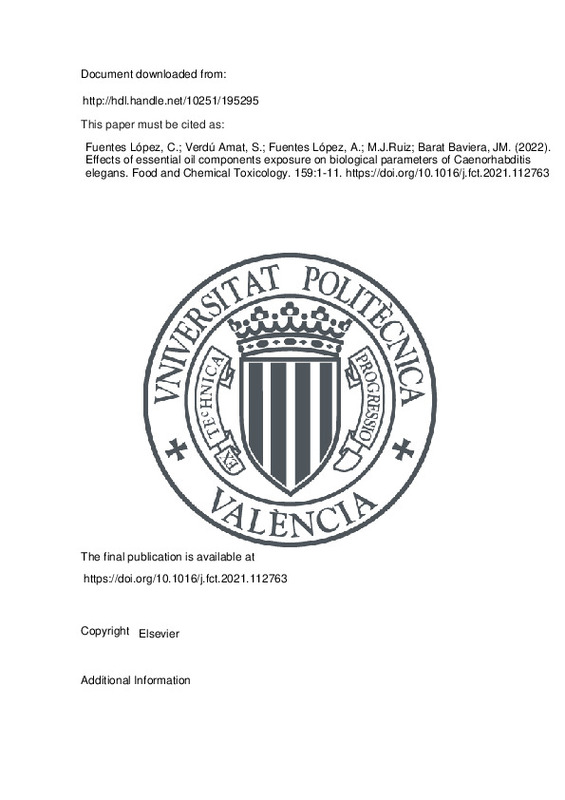JavaScript is disabled for your browser. Some features of this site may not work without it.
Buscar en RiuNet
Listar
Mi cuenta
Estadísticas
Ayuda RiuNet
Admin. UPV
Effects of essential oil components exposure on biological parameters of Caenorhabditis elegans
Mostrar el registro sencillo del ítem
Ficheros en el ítem
| dc.contributor.author | Fuentes López, Cristina
|
es_ES |
| dc.contributor.author | VERDÚ AMAT, SAMUEL
|
es_ES |
| dc.contributor.author | Fuentes López, Ana
|
es_ES |
| dc.contributor.author | M.J.Ruiz
|
es_ES |
| dc.contributor.author | Barat Baviera, José Manuel
|
es_ES |
| dc.date.accessioned | 2023-07-20T18:01:57Z | |
| dc.date.available | 2023-07-20T18:01:57Z | |
| dc.date.issued | 2022-01 | es_ES |
| dc.identifier.issn | 0278-6915 | es_ES |
| dc.identifier.uri | http://hdl.handle.net/10251/195295 | |
| dc.description.abstract | [EN] The extensive use of essential oil components in an increasing number of applications can substantially enhance exposure to these compounds, which leads to potential health and environmental hazards. This work aimed to evaluate the toxicity of four widely used essential oil components (carvacrol, eugenol, thymol, vanillin) using the in vivo model Caenorhabditis elegans. For this purpose, the LC50 value of acute exposure to these components was first established; then the effect of sublethal concentrations on nematodes' locomotion behaviour, reproduction, heat and oxidative stress resistance and chemotaxis was evaluated. The results showed that all the components had a concentration-dependent effect on nematode survival at moderate to high concentrations. Carvacrol and thymol were the two most toxic compounds, while vanillin had the mildest toxicological effect. Reproduction resulted in a more sensitive endpoint than lethality to evaluate toxicity. Only pre-exposure to carvacrol and eugenol at the highest tested sublethal concentrations conferred worms oxidative stress resistance. However, at these and lower concentrations, both components induced reproductive toxicity. Our results evidence that these compounds can be toxic at lower doses than those required for their biological action. These findings highlight the need for a specific toxicological assessment of every EOC application. | es_ES |
| dc.description.sponsorship | This research has been supported by the Spanish Government (Project RTI2018-101599-B-C21 (MCUI/AEI/FEDER, EU)). The C. elegans strain was provided by the CGC, which is funded by the NIH Office of Research Infrastructure Programmes (P40 OD010440). | es_ES |
| dc.language | Inglés | es_ES |
| dc.publisher | Elsevier | es_ES |
| dc.relation.ispartof | Food and Chemical Toxicology | es_ES |
| dc.rights | Reconocimiento - No comercial - Sin obra derivada (by-nc-nd) | es_ES |
| dc.subject | Nematode | es_ES |
| dc.subject | Toxicity | es_ES |
| dc.subject | Carvacrol | es_ES |
| dc.subject | Thymol | es_ES |
| dc.subject | Eugenol | es_ES |
| dc.subject | Vanillin | es_ES |
| dc.subject.classification | TECNOLOGIA DE ALIMENTOS | es_ES |
| dc.title | Effects of essential oil components exposure on biological parameters of Caenorhabditis elegans | es_ES |
| dc.type | Artículo | es_ES |
| dc.identifier.doi | 10.1016/j.fct.2021.112763 | es_ES |
| dc.relation.projectID | info:eu-repo/grantAgreement/AEI/Plan Estatal de Investigación Científica y Técnica y de Innovación 2017-2020/RTI2018-101599-B-C21/ES/DESARROLLO Y APLICACION DE SISTEMAS ANTIMICROBIANOS PARA LA INDUSTRIA ALIMENTARIA BASADOS EN SUPERFICIES FUNCIONALIZADAS Y SISTEMAS DE LIBERACION CONTROLADA/ | es_ES |
| dc.relation.projectID | info:eu-repo/grantAgreement/NIH//P40 OD010440/ | es_ES |
| dc.rights.accessRights | Abierto | es_ES |
| dc.contributor.affiliation | Universitat Politècnica de València. Departamento de Tecnología de Alimentos - Departament de Tecnologia d'Aliments | es_ES |
| dc.contributor.affiliation | Universitat Politècnica de València. Escuela Técnica Superior de Ingeniería Agronómica y del Medio Natural - Escola Tècnica Superior d'Enginyeria Agronòmica i del Medi Natural | es_ES |
| dc.description.bibliographicCitation | Fuentes López, C.; Verdú Amat, S.; Fuentes López, A.; M.J.Ruiz; Barat Baviera, JM. (2022). Effects of essential oil components exposure on biological parameters of Caenorhabditis elegans. Food and Chemical Toxicology. 159:1-11. https://doi.org/10.1016/j.fct.2021.112763 | es_ES |
| dc.description.accrualMethod | S | es_ES |
| dc.relation.publisherversion | https://doi.org/10.1016/j.fct.2021.112763 | es_ES |
| dc.description.upvformatpinicio | 1 | es_ES |
| dc.description.upvformatpfin | 11 | es_ES |
| dc.type.version | info:eu-repo/semantics/publishedVersion | es_ES |
| dc.description.volume | 159 | es_ES |
| dc.identifier.pmid | 34896182 | es_ES |
| dc.relation.pasarela | S\452079 | es_ES |
| dc.contributor.funder | AGENCIA ESTATAL DE INVESTIGACION | es_ES |
| dc.contributor.funder | European Regional Development Fund | es_ES |
| dc.contributor.funder | National Institutes of Health, EEUU | es_ES |







![[Cerrado]](/themes/UPV/images/candado.png)

